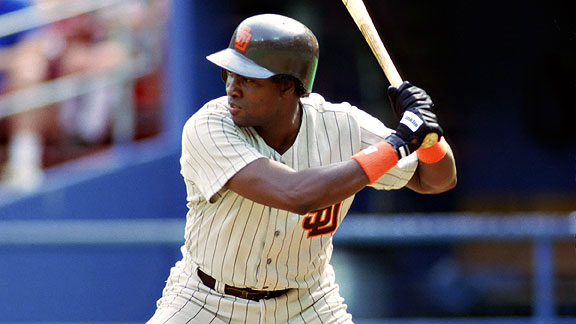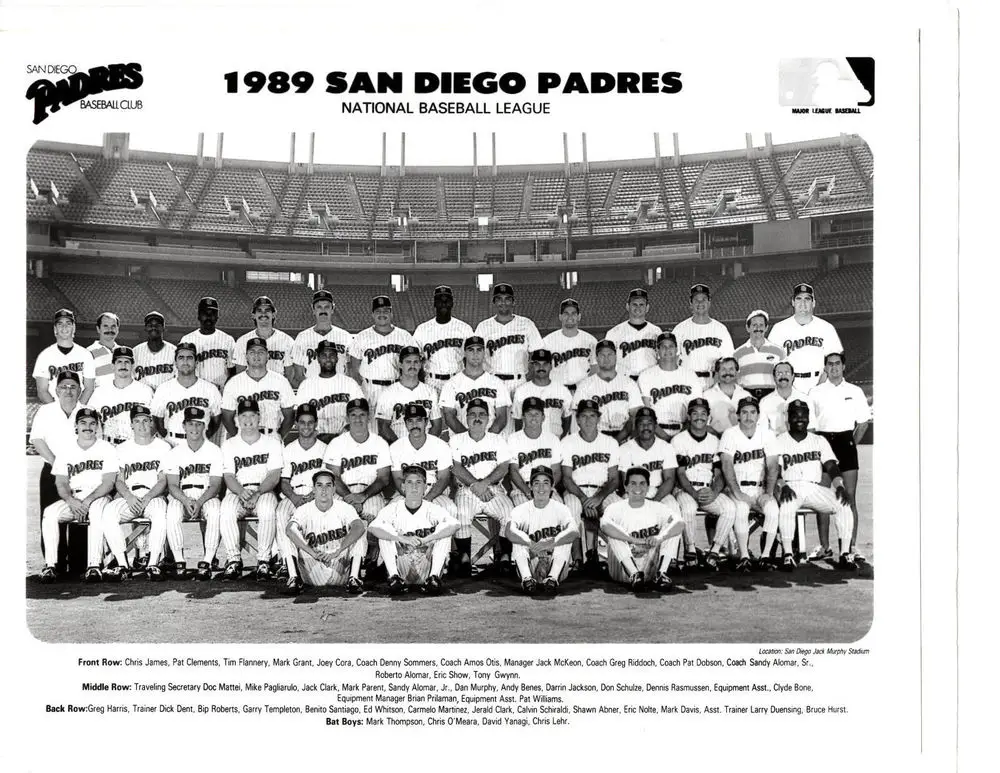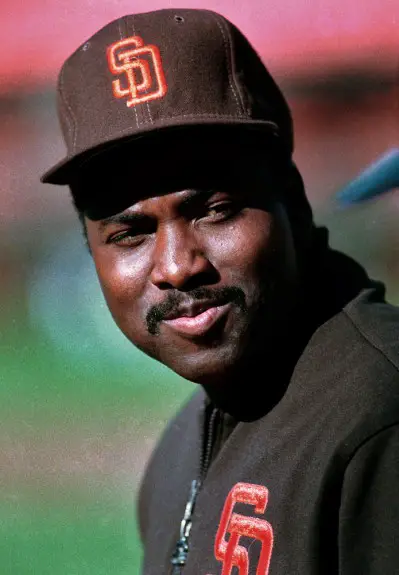The 1989 Padres – The Season That Could Have Been


The 1989 Padres – The Season That Could Have Been
by Jeffrey Pilch aka @texpadres
For many longtime Padres beisbolistas, 1989 was one of the more exciting seasons in the franchise’s history.
There was no champagne flowing or flag raising after the season. With 89 wins, the Padres had the third-best record in the National League and fifth-best in baseball.
In the pre-wildcard era, though, that wasn’t good enough for a playoff berth. This team could’ve won a postseason series, or more, if given a chance.
The Padres season included a Cy Young award for relief pitcher Mark Davis and a batting title, won on the last game of the season, by legendary outfielder Tony Gwynn.
San Francisco first baseman Will Clark and Gwynn came into game 162 in a virtual tie for the best batting average in the National League. The Giants and Padres faced each other at San Diego’s Jack Murphy Stadium, and fans were treated to a one-on-one contest for the batting championship.
Gwynn won the title by going three-for-four to finish at .336, while Clark went one-for-four. A single in the eighth inning-his 203rd hit of the year-sealed the crown and provoked a five-minute standing ovation.
Notwithstanding the dramatic conclusion, Gwynn’s season was just a typical component of his Hall of Fame career. Davis’ success in his 10th big-league season -44 saves and a 1.85 ERA-was a stunning outlier in what would be a 15-year career.
A converted starter who first came to the majors as a 19-year-old with the World Series-winning Philadelphia Phillies in 1980, Davis became a closer for the first time with the Padres in 1988, when he recorded 28 saves and a 2.01 ERA. Other than ’88 and ’89, Davis never recorded more than seven saves, and he retired in 1993 with a career ERA of 4.17.
To appreciate the ’89 Padres season, one must look back a couple of years to see how the organization’s on-field leadership evolved.
The ’87 squad, led by fiery first-year manager Larry Bowa, lost 97 games after a franchise-worst 12-42 start. The Padres roster was full moneyslot of talented young players-like Benito Santiago, outfielder Shane Mack, infielder Joey Cora and first baseman John Kruk -who needed the patience that Bowa lacked.
The 42-year-old Bowa, who retired in 1985 after 16 seasons as a major-league shortstop, tried to make adjustments going into the ’88 season.
“He’s (Bowa) not as psycho this year,” Kruk was quoted as saying. “He hasn’t acted like as much of an idiot. Not yet”.
“This is year is much more relaxed,” veteran right-hander Ed Whitson was reported to say early in ’88. “Last year, you were always wondering when the next explosion would come. Everyone was on edge.
It didn’t help. After a 16-30 start, Bowa was fired on May 27.
Padres general manager Jack McKeon, 58, took over on May 28th, and the organization’s outlook seemed to improve from that moment on. McKeon, who had previously managed in Kansas City and Oakland, was regarded as a players’ manager.

“Padres’ batteries are charged as days of gloom and doom behind’ –Padres beat writer Kevin Kernan of the SD Union – February 19, 1989
The Padres closed the ’88 season by playing .583 baseball, going 67-48 under McKeon. After the strong finish and the acquisition of Jack Clark and ace Bruce Hurst.-the latter coming after a public-pressure campaign targeting both the pitcher and San Diego management-there was justified optimism in the off-season.
“Now Jack Clark is on our side. I think if we had been sitting down we would have stood up and applauded,” a smiling Tony Gwynn said. “It was like, ‘Yeah, he is really ours”.
The public pressure campaign to land Hurst was like nothing the San Diego sports community had ever seen. One of the wealthier Padres fans rented out an airplane to streak across the blue St. George sky, trailing a banner with this message. “Two million Padres fans, 500 miles to the west. In addition, 10,000 hopeful Padres fans sent their signatures to Utah hoping to convince Hurst with a petition”.
The San Diego Union sports section summed up the excitement of the Hurst signing:
“Swooping into town to the figurative blare of red carpets and trumpets, and a literal bestowing of a key to the city- Bruce Hurst soon may qualify for sainthood, as much a modern-day Bruce of Arc as a Dizzy Hurst,” Dec 12, 1988.
“It’s funny,” pitcher Mark Grant stated during spring training, “I was driving over here thinking about the playoffs and what this team can accomplish this season”.
“Padres’ batteries are charged as days of gloom and doom behind.” – February 19, 1989
With two new star players and a base that included Benito Santiago, infielder Roberto Alomar, Davis and of course Gwynn, the Padres were widely favored to win the National League West title, even over the defending world champion Los Angeles Dodgers. This was rarefied air for a team that had only previously made the postseason once (in 1984, with McKeon as general manager).
But the Padres lost the first two games of the ’89 season to the eventual division-winning (and league winning) San Francisco Giants and struggled under the weight of high expectations all year. It didn’t take long for the media to turn on the team.
“What might have been considered heresy last winter when (team President) Dick Freeman and Jack McKeon were in the process of building the 1989 Padres has come to pass,” Barry Bloom wrote in the San Diego Evening Tribune on May 15, “They are in last place. For the first time since the final day of the 1987 season, when a grave already was being dug for former manager Larry Bowa, the Padres are lone inhabitants of the cellar.”
The Padres actually closed May with a winning record at 29-25, but June and July were disastrous as they fell below .500 and drifted further behind the Giants.
Much of the media’s and fans’ frustration was directed at Jack Clark, who only hit seven homers with a .219 batting average during the season’s first three months. McKeon was also criticized for being too easy on the players and on his in-game strategy.
Perhaps in panic after the slower-than-expected start, McKeon tried to become more a disciplinarian. A headline in the May 6 Evening Tribune read” McKeon tries to whip on reeling Padres.”
McKeon benched the struggling Santiago. A Bloom piece titled “Santiago benching doesn’t sit well” on May 9 added to the tumult.
PAGE 2 LINK BELOW
Jeffrey grew up in Carlsbad and has been a Padres fan since the late 70’s. He is currently a Social Studies teacher at Newman Smith High School in Carrollton, Texas.
1989,man what a year I was at jack Murphy stadium for the 3 game series vs Cincinnati. Still remember the giants had lost that day,so a padre win and that Friday tru Sunday series SF was gonna be for the NL west title!but that Thursday night game went 13 innings and still remember Barry Larkin driving in Mariano Dunkin and Ron Oeyster in the top of the 13th REDS 3 PADRES 1
There would be no 3 game show down
I remember watching ESPN that night and saw Giant fans listening to their radios and Giant players watching in their clubhouse the SD vs CIN final,they celebrated as GaryvTempleton struck out “the Giants win the NL west said the espn broadcaster” sure wish therevwoukd have been a wild card! CHI VS SD (REMATCH OF 84″)SF VS PIT(4TH BEST RECORD IN NL)so many what could have been not even the 2007 letdown for a shot at the postseason was bad
But 1989 will be ,in padre history,the year of so many what could’ve been andvwhat ifs
Still curse Schiraldi for that Davis AB. Double off the wall. Listening to Jerry call it. What’s with him and being in big losses? Of course we all wish they’d walked Davis, but I’m guessing we’d be talking about Schiraldi in that case too.
I remember being so disappointed to be that close to the playoffs after that season that I divorced from baseball til 1998.
Thanks for writing this. 1989 was my first Padres season as a young fan, and it really got me excited about baseball for the first time. So many great players on that team — Gwynn, Alomar, Santiago, Clark, Hurst, Benes, etc. They were in contention until the very end, and Mark Davis winning the Cy Young was the exclamation point on a successful season.
I remember being so excited for the 1990 season, only to be viciously disappointed by all that happened next (Davis going to KC, Chris James traded, Joe Carter underperforming, Santiago getting injured, etc.). That’s baseball, I guess.